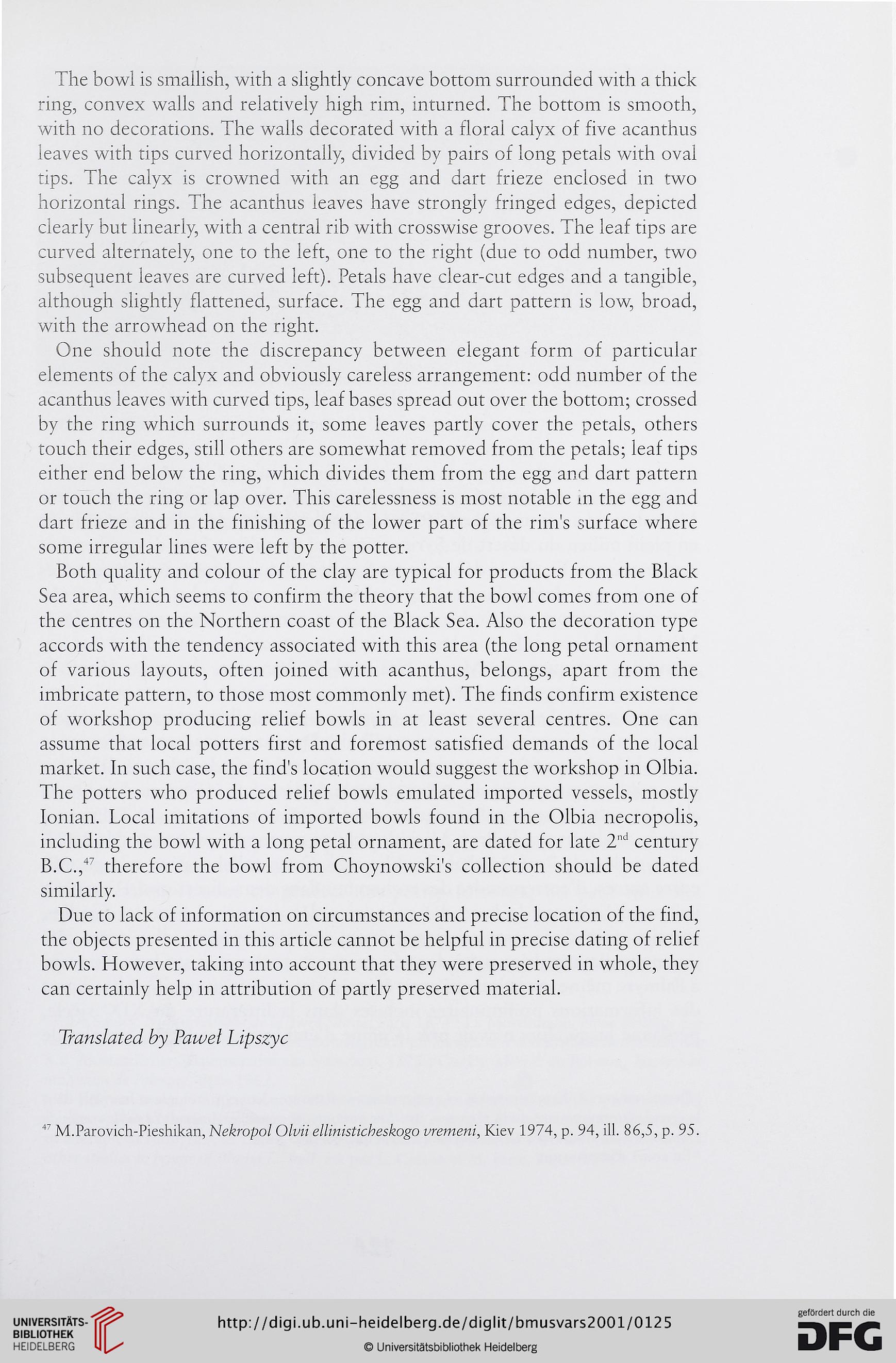The bowl is smallish, with a slightly concave bottom surrounded with a thick
ring, convex walls and relarively high rim, inturned. The bottom is smooth,
with no decorations. The walls decorated with a floral calyx of five acanthus
leaves with tips curved horizontally, divided by pairs of long petals with oval
tips. The calyx is crowned with an egg and dart frieze enclosed in two
horizontal rings. The acanthus leaves have strongly fringed edges, depicted
clearly but linearly, with a central rib with crosswise grooves. The leaf tips are
curved alternately, one to the left, one to the right (due to odd number, two
subseąuent leaves are curved left). Petals have clear-cut edges and a tangible,
although slightly flattened, surface. The egg and dart pattern is Iow, broad,
with the arrowhead on the right.
One should notę the discrepancy between elegant form of particular
elements of the calyx and obviously careless arrangement: odd number of the
acanthus leaves with curved tips, leaf bases spread out over the bottom; crossed
by the ring which surrounds it, some leaves partly cover the petals, others
touch their edges, still others are somewhat removed from the petals; leaf tips
either end below the ring, which divides them from the egg and dart pattern
or touch the ring or lap over. This carelessness is most notable m the egg and
dart frieze and in the finishing of the lower part of the rim's surface where
some irregular lines were left by the potter.
Both ąuality and colour of the clay are typical for products from the Black
Sea area, which seems to confirm the theory that the bowl comes from one of
the centres on the Northern coast of the Black Sea. Also the decoration type
accords with the tendency associated with this area (the long petal ornament
of various layouts, often joined with acanthus, belongs, apart from the
imbricate pattern, to those most commonly met). The finds confirm existence
of workshop producing relief bowls in at least several centres. One can
assume that local potters first and foremost satisfied demands of the local
market. In such case, the find's location would suggest the workshop in Olbia.
The potters who produced relief bowls emulated imported vessels, mostly
Ionian. Local imitations of imported bowls found in the Olbia necropolis,
including the bowl with a long petal ornament, are dated for late 2nd century
B.C.,4/ therefore the bowl from Choynowski's collection should be dated
similarly.
Due to lack of information on circumstances and precise location of the find,
the objects presented in this article cannot be helpful in precise dating of relief
bowls. However, taking into account that they were preserved in whole, they
can certainly help in attribution of partly preserved materiał.
Translated by Paweł Lipszyc
47 M.Parovich-Pieshikan, Nekropol Olvii ellinisticheskogo uremeni, Kiev 1974, p. 94, ill. 86,5, p. 95.
ring, convex walls and relarively high rim, inturned. The bottom is smooth,
with no decorations. The walls decorated with a floral calyx of five acanthus
leaves with tips curved horizontally, divided by pairs of long petals with oval
tips. The calyx is crowned with an egg and dart frieze enclosed in two
horizontal rings. The acanthus leaves have strongly fringed edges, depicted
clearly but linearly, with a central rib with crosswise grooves. The leaf tips are
curved alternately, one to the left, one to the right (due to odd number, two
subseąuent leaves are curved left). Petals have clear-cut edges and a tangible,
although slightly flattened, surface. The egg and dart pattern is Iow, broad,
with the arrowhead on the right.
One should notę the discrepancy between elegant form of particular
elements of the calyx and obviously careless arrangement: odd number of the
acanthus leaves with curved tips, leaf bases spread out over the bottom; crossed
by the ring which surrounds it, some leaves partly cover the petals, others
touch their edges, still others are somewhat removed from the petals; leaf tips
either end below the ring, which divides them from the egg and dart pattern
or touch the ring or lap over. This carelessness is most notable m the egg and
dart frieze and in the finishing of the lower part of the rim's surface where
some irregular lines were left by the potter.
Both ąuality and colour of the clay are typical for products from the Black
Sea area, which seems to confirm the theory that the bowl comes from one of
the centres on the Northern coast of the Black Sea. Also the decoration type
accords with the tendency associated with this area (the long petal ornament
of various layouts, often joined with acanthus, belongs, apart from the
imbricate pattern, to those most commonly met). The finds confirm existence
of workshop producing relief bowls in at least several centres. One can
assume that local potters first and foremost satisfied demands of the local
market. In such case, the find's location would suggest the workshop in Olbia.
The potters who produced relief bowls emulated imported vessels, mostly
Ionian. Local imitations of imported bowls found in the Olbia necropolis,
including the bowl with a long petal ornament, are dated for late 2nd century
B.C.,4/ therefore the bowl from Choynowski's collection should be dated
similarly.
Due to lack of information on circumstances and precise location of the find,
the objects presented in this article cannot be helpful in precise dating of relief
bowls. However, taking into account that they were preserved in whole, they
can certainly help in attribution of partly preserved materiał.
Translated by Paweł Lipszyc
47 M.Parovich-Pieshikan, Nekropol Olvii ellinisticheskogo uremeni, Kiev 1974, p. 94, ill. 86,5, p. 95.




